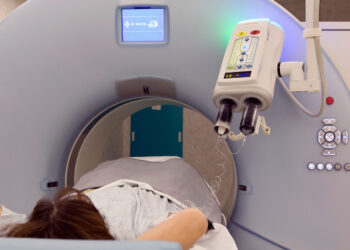
3D illustration of a quantum computer
adventtr/Getty Images
For all the hype surrounding quantum computers, the technology can sometimes appear to be a solution in search of a problem. Scientifically impressive, but not yet obviously useful in the real world. However, the hunt for applications is now starting to yield results – in particular the pursuit of exotic quantum materials that could supercharge the development of novel electronics and even more powerful computing systems.
Discovering and probing new phases – that is, more exotic equivalents of the ice or liquid phases of water – is the bread-and-butter of condensed matter physics. This field has helped us understand semiconductors that make traditional computers work and may eventually give us practical superconductors, which would conduct electricity with perfect efficiency.
But it is becoming increasingly difficult to use traditional experiments to study some of the more complex phases that theory predicts should exist. For instance, a theoretical framework known as the Kitaev honeycomb model predicts the existence of materials exhibiting unusual types of magnetism, and also those that contain unusual quasiparticles – particle-like entities – known as anyons. In fact, there has been a “decades-long quest to actually engineer this in real-world materials”, says Simon Evered at Harvard University.
He and his colleagues have now simulated this using a quantum computer that has 104 qubits made from extremely cold atoms. And they aren’t the only researchers to do so. Frank Pollmann at the Technical University of Munich in Germany and his colleagues used Google’s Sycamore and Willow quantum computers, which house 72 and 105 superconducting qubits, respectively, to simulate a never-before-seen state of matter that also stems from a version of the Kitaev honeycomb model. Both teams have published their studies.
“These two papers use quantum computers to explore new phases of matter that have so far only been predicted in theory, but not realised in experiments,” says Petr Zapletal at the University of Erlangen-Nuremberg in Germany, who wasn’t involved in either study. “What’s exciting is how quickly simulations of quantum and condensed matter systems on quantum computers are becoming more advanced”.
Both research teams confirmed the presence of anyons in their simulations. This in itself shows both the progress of quantum computers and their eventual utility, because anyons are exotic particles that are fundamentally different from qubits and are therefore difficult to emulate.
All other existing particles fall into two other categories – fermions and bosons. Those that are most interesting to chemists and materials scientists are typically fermions, but qubits tend to be bosons. The differences between the two, such as their spins or how they behave in large groups, makes it tricky to simulate fermions if you start with bosons, but the cold-atom quantum computer experiment used the Kitaev model to bridge the gap. Marcin Kalinowski at Harvard University, who worked on this experiment, says that they used the Kitaev model as a “canvas” for new physics – starting with this model, he and his colleagues could nudge quasiparticles to emerge in the simulation by tuning the interactions between the qubits. It might even then be possible to use some of those new particles to simulate more novel materials, says Kalinowski.
The experiment that used Google’s computers included one other important element. It focused on taking the simulated material out of equilibrium – the equivalent of constantly shaking it. Non-equilibrium phases of matter are largely unexplored even though they have counterparts in the lab, such as experiments where a material is repeatedly hit by laser light, says Pollmann. In this way the work by his team mirrors how a condensed matter physicist in the lab may expose a material to cold temperatures or high magnetic fields and then try to diagnose how its phase has changed. Such diagnoses are vital because they can ultimately reveal under what circumstances the material could be put to use.
To be clear, these experiments won’t immediately lead to something useful. In fact, to get to real world applications, researchers will have to repeat their analyses on larger and less error-prone quantum computers – the kind that we still don’t really have. But the two experiments carve out a niche where quantum computers can explore physics and possibly lead to discoveries in a similar way to the other experimental tools researchers have used for decades.
That materials science may be the first place quantum computers prove their worth is no shock. It is in line with how progenitors of quantum computing, such as Richard Feynman, spoke about the technology in the 1980s, long before anyone knew how to make a single qubit, let alone dozens. And it is markedly different to the way quantum computing is often presented, where the emphasis is on experiments that showcase quantum computers outperforming classical computers in tasks unrelated to practical applications.
“The value in terms of developing quantum computing as an approach to science, rather than just from the perspective of performance of individual devices, is undisputable in these kinds of experiments,” says Kalinowski.
Topics:
Source link : https://www.newscientist.com/article/2496013-quantum-computers-are-finally-on-the-verge-of-being-useful/?utm_campaign=RSS%7CNSNS&utm_source=NSNS&utm_medium=RSS&utm_content=home
Author :
Publish date : 2025-09-18 09:00:00
Copyright for syndicated content belongs to the linked Source.














